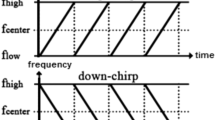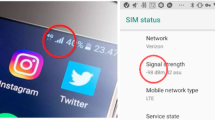Abstract
The Heterogeneous Network (HetNet) based ultra-dense network is the possible solution to cope up with the exponential growth in data traffic. The HetNet deployment provides benefits of load balancing, better connectivity and higher data rate to the users. However, the diversity in transmit power results in downlink (DL)/uplink (UL) imbalance and poses a serious issue in mobility management. Adoption of DL/UL decoupled (DUDe) handover (HO) method where DL and UL HO occurs separately which could possibly improve the user’s quality of service and network performance. The control parameters involved in this DUDe HO procedure should be properly configured to achieve the expected performance. In this work, simulation analysis has been carried out to explore the dependency of these control parameters on various factors such as Inter-Site-Distance (ISD), velocity and offloading. The analytical results provide interesting insights about the control parameter configuration in decoupled wireless connection. From the analysis results, measurement configuration strategy has been developed to configure the HCP in decoupled HO method. The results show the proposed method achieves increase in dwell time when compared to the legacy coupled HO method.












Similar content being viewed by others
Data Availability
There is no dataset used, the data used in the analysis are simulated and the simulation procedure is mentioned in the manuscript. And wherever the standard information is used, the source of it is cited in the manuscript.
References
Saad, W., Bennis, M., & Chen, M. (2020). A vision of 6G wireless systems: Applications, trends, technologies, and open research problems. IEEE Network, 34(3), 134–142.
Jain, A., Lopez-Aguilera, E., & Demirkol, I. (2020). Are mobility management solutions ready for 5G and beyond. Computer Communications, 161, 50–75.
Ye, Q., Rong, B., Chen, Y., Al-Shalash, M., Caramanis, C., & Andrews, J. G. (2013). User association for load balancing in heterogeneous cellular networks. IEEE Transactions on Wireless Communications, 12(6), 2706–2716.
Novlan, T. D., Dhillon, H. S., & Andrews, J. G. (2013). Analytical modeling of uplink cellular networks. IEEE Transactions on Wireless Communications, 12(6), 2669–2679.
Smiljkovikj, K., Popovski, P., & Gavrilovska, L. (2015). Analysis of the decoupled access for downlink and uplink in wireless heterogeneous networks. IEEE Wireless Communications Letters, 4(2), 173–176.
Boccardi, F., Andrews, J., Elshaer, H., Dohler, M., Parkvall, S., Popovski, P., & Singh, S. (2016). Why to decouple the uplink and downlink in cellular networks and how to do it. IEEE Communications Magazine, 54(3), 110–117.
Giluka, M. K., Khan, M. S. A., Krishna, G. M., Atif, T. A., Sathya, V., Tamma, B. R., (2016) On handovers in uplink/downlink decoupled LTE HetNets. IEEE Wireless Communications and Networking Conference.
3GPP, TS 36.331, Evolved Universal Terrestrial Radio Access (E-UTRA); Radio Resource Control (RRC); Protocol specification, Version 15.9.0, Release 15, April 2020.
Munoz, P., Barco, R., & de la Bandera, I. (2013). On the potential of handover parameter optimization for self-organizing networks. IEEE Transactions on Vehicular Technology, 62(5), 1895–1905.
Munoz, P., Barco, R., & de la Bandera, I. (2013). Optimization of load balancing using fuzzy Q-Learning for next generation wireless networks. Elsevier - International journal of expert systems with applications, 40, 984–994.
Lim, J., & Hong, D. (2013). Mobility and Handover management for heterogeneous networks in LTE-advanced. Springer - Journal of Wireless Personal Communication, 72(4), 2901–2912.
Kollias, G, Adelantado, F, Vardakas, J & Ramantas, K, (2014). Handover performance in LTE-A HetNets through inter-site distance differentiation. International workshop on computer aided modeling and design of communication links and networks, 280 – 284.
Mehta, M., Akhtar, N., Karandikar, A., (2015). Impact of Handover Parameters on Mobility Performance in LTE HetNets. National Conference on Communications, 1–6.
Munoz, P., Barco, R., & de la Bandera, I. (2015). Load balancing and handover joint optimization in LTE networks using fuzzy logic and reinforcement learning. Elsevier-International journal of computer networks, 76, 112–125.
Mwanje, S. S., Schmelz, L. C., & Mitschele-Thiel, A. (2016). Cognitive cellular networks: A Q-Learning framework for self-organizing networks. IEEE Transactions on network and service management, 13(1), 85–98.
Chaudhuri, S., Baig, I., & Das, D. (2017). Self-organizing method for handover performance optimization in LTE-advanced network. Elsevier-International Journal of Computer Communications, 110, 151–163.
Huang, M., & Chen, J. (2018). A conflict avoidance scheme between mobility load balancing and mobility robustness optimization in self-organizing networks. Springer-International Journal of Wireless Networks, 24(1), 271–281.
Hegazy, R. D., Nasr, O. A., & Kamal, H. A. (2018). Optimization of user behavior based handover using fuzzy Q-learning for LTE networks. Springer-International Journal of Wireless Networks, 24(2), 481–495.
Castro-Hernandez, D., & Paranjape, R. (2018). Optimization of handover parameters for LTE/LTE-A in-building systems. IEEE Transactions on Vehicular Technology, 67(6), 5260–5273.
Saraswathi Priyadharshini, A., & Bhuvaneswari, P. T. V. (2019). Regression Model for seamless mobility in LTE-A HetNets. Transactions on Emerging Telecommunications Technologies, 30(8), 1–16.
Goyal, T., & Kaushal, S. (2019). Handover optimization scheme for LTE-Advance networks based on AHP-TOPSIS and Q-learning. Elsevier - International journal of computer communications, 133, 67–76.
Priyadharshini, A. S., Bhuvaneswari, P.T.V. (2017). Interdependency analysis of angle of UE movement and inter-site-distance on configuration of handover control parameter in LTE-A HetNets. IEEE-International conference on Signal Processing, Communication and Networking.
3GPP, TR 36.839 - Evolved Universal Terrestrial Radio Access (E-UTRA); Mobility enhancements in heterogeneous networks, Release 11, 2015.
3GPP, TR 36.814, Evolved Universal Terrestrial Radio Access (E-UTRA); Further advancements for E-UTRA physical layer aspects, Release 9, V9.0.0, March 2010.
Funding
Authors declare that there is no funding support for this research work.
Author information
Authors and Affiliations
Corresponding author
Ethics declarations
Conflict of interest
Authors declare that there are no conflicts of interest among themselves.
Additional information
Publisher's Note
Springer Nature remains neutral with regard to jurisdictional claims in published maps and institutional affiliations.
Rights and permissions
Springer Nature or its licensor (e.g. a society or other partner) holds exclusive rights to this article under a publishing agreement with the author(s) or other rightsholder(s); author self-archiving of the accepted manuscript version of this article is solely governed by the terms of such publishing agreement and applicable law.
About this article
Cite this article
Saraswathi Priyadharshini, A., Mary Saira Bhanu, S. Measurement Configuration Strategy for Decoupled Handover in Beyond 5G Networks. Wireless Pers Commun 129, 1735–1751 (2023). https://doi.org/10.1007/s11277-023-10204-x
Accepted:
Published:
Issue Date:
DOI: https://doi.org/10.1007/s11277-023-10204-x




